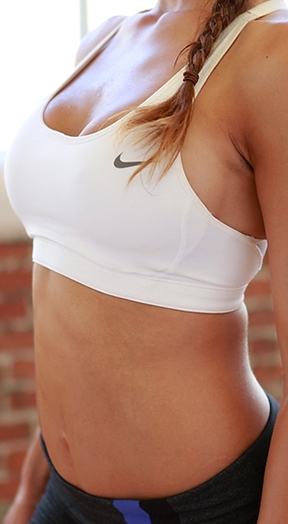During breast reconstruction surgery, the surgeon can rebuild the breast mound to produce the feminine curves that have been lost to breast cancer treatment. This can greatly improve a patient’s self-confidence, and provide a natural looking shape that fills out clothing, bathing suits, and undergarments. However, if the nipple and areola were removed during the mastectomy, the patient may feel that the breast looks incomplete. For patients who did not undergo nipple-sparing mastectomy, the final step of the breast reconstruction process is nipple and areola reconstruction. Bay Area Plastic Surgeon John R. Griffin can advise patients on surgical and non-surgical nipple and areola reconstruction options, and assist them in choosing the approach that best suits their needs.
Candidates
Candidates for areola and nipple reconstruction include patients who were unable to undergo a nipple-sparing mastectomy. The non-surgical technique, nipple and areola tattooing, can be safely and successfully performed on all interested patients. Good candidates for surgical nipple and areola reconstruction techniques include those who:
- Have sufficient, healthy skin on the breasts.
- Are ready to undergo an additional surgery on the breasts.
- Know that a history of radiation therapy can lead to an increased risk of complications.
- Understand that the reconstructed nipple may lose some of its projection. In this case additional surgery, or the use of dermal fillers or fat grafting, may be used to improve nipple projection.
Techniques
Nipple and areola reconstruction techniques can be performed after breast symmetry has been achieved and the patient has recovered from her prior surgeries. Patients can undergo surgical nipple reconstruction methods along with tattooing, or they can undergo the tattooing technique on its own. The decision is made based on the patient’s preferences, and the quality of the breast skin and tissue.
Local Skin Flaps for Nipple Reconstruction
Modern nipple reconstruction techniques involve the use of a local skin flap to create the nipple mound. Dr. Griffin can employ the skate, C-V, or star flap techniques to reconstruct the nipple. These approaches involve an incision around the site of the new nipple. The outer skin and tissues are then elevated and brought together to its center, providing the surgeon with tissue to rebuild the nipple mound. This local skin flap produces the nipple projection, and also mimics the texture of the nipple. Once the nipple has been formed, the incisions are closed.
As the patient heals and time passes, it is possible for the nipple to lose some of its elevation. In this case, a revision procedure can be performed. Dr. Griffin may use fat injections or dermal fillers to add forward projection to the nipple. An additional skin flap treatment can also be performed to improve nipple projection.
Skin Grafts for Areola Reconstruction
To reconstruct the texture and contour of the areola, a skin graft procedure can be performed. The graft of skin is usually taken from the site where the initial flap of skin was removed to rebuild the breast mound. For example, if the patient underwent DIEP or SIEA flap surgery, the skin graft would be taken from the lower abdomen, right next to the site of the healed scar. The skin graft is then transferred to the breast, where the surgeon shapes it to re-create the areola.
The areola skin graft technique can be performed at the same time as the skin flap nipple reconstruction procedure, or on its own a couple of months after the nipple reconstruction procedure.
Tattooing
While the local skin flap and skin graft reconstruction techniques can restore the contour and texture of the nipple and areola, they can’t produce the natural color of these features. Nipple areola tattooing can be performed as the finishing touch of the breast reconstruction process.
The areola nipple tattooing procedure may be performed after the nipple and areola surgical reconstruction procedures. In this case, the tattooing treatment is performed after the nipple and areola have completely healed, typically two to three months after the nipple and areola reconstruction procedures. Patients can also choose to have the tattooing treatment done alone. In this case, the tattooing procedure can be performed after the reconstructed breast mound has healed.
The tattooing procedure takes about one hour to perform. A secondary tattooing session may be required to produce the best color and tone for the patient. For patients who require nipple areola tattooing for just one breast, the surgeon can closely match the coloring of the existing breast by mixing the appropriate pigments. In patients who require treatment on both breasts, the coloring can be matched to photos taken of the breasts prior to the mastectomy, or a color can be chosen to complement your skin tone.
Consultations
To schedule an appointment regarding areola and nipple reconstruction, contact Dr. John R. Griffin’s practice today.







